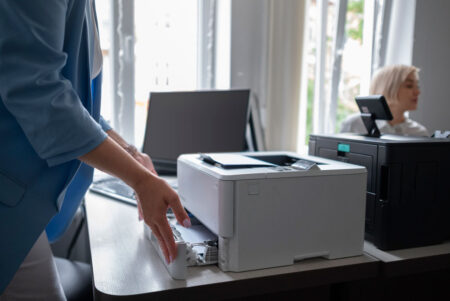Get the most out of your copier by following these expert copier maintenance tips.
A copier is integral to your small business location. For businesses that distribute brochures, flyers and other branded documents, it’s helpful to have a machine that allows you to produce a large volume of high-quality copies.
If your business has invested in a copier, you want to do everything you can to maintain it and extend its life, especially if you use it frequently. After all, it’s often less expensive to keep an old copier running smoothly than invest in a new one.
To help you do this, here are some copier maintenance tips to ensure you get the most out of your machine.

Do offices need copiers?
Copiers are important additions to offices, as they allow you to create countless important documents on demand. Without an office copier, you may spend a lot of money elsewhere to produce the number of copies you need. Copiers use different printing systems than regular printers, using less-expensive ink and printing more copies at a faster rate.
Depending on your company’s copying or printing needs, an office copier is typically a must-have, as it eliminates the time and money required to yield your anticipated results.
Why is copier maintenance important?
An office copier is one of the most useful yet expensive pieces of equipment you can invest in. And, unfortunately, copier repairs are especially costly. It’s important, therefore, to keep up with your copier’s maintenance to ensure your machine is performing at its best and lasting as long as it can.
How long do copiers usually last?
An office copier’s lifespan depends on a few factors. For instance, overusing your copier (i.e., exceeding its maximum page output regularly) or failing to keep up on maintenance (e.g., filling toner or having maintenance services performed) greatly decreases its lifespan. All things considered, the average lifespan of a copier is between three to five years.
Did you know? The average copier lasts between three to five years.
How often should a copier be serviced?
The frequency of regular service checkups for a copier varies. It depends on the estimated copy volume, the model of the copier, existing mechanical issues (like paper jams, ink guzzling and overheating) and more. Typically, the higher the copy volume, the lower the per-copy fee. Most copier maintenance agreements cover preventative and remedial repairs.
What is a copier maintenance agreement?
If it is available, it’s wise to purchase a copier maintenance agreement with your machine. This contract typically includes regular maintenance information regarding your machine, as well as a timeline of when you should perform maintenance and whom to call. For example, most copier maintenance agreements include regular service checkups (based on your estimated copy volume), and some software will alert you when it’s time to replace a part of the machine.
Your agreement should also cover the cost of a service technician to repair any mechanical issues. This typically includes both preventative and remedial repairs (e.g., service calls and unscheduled repair calls). It also often includes the cost of transportation, labor, replacement parts and operating supplies.
While you technically could perform some maintenance tasks on your own, there are many important tasks that require the help of a professional technician. The more regular maintenance your copier maintenance agreement covers, the longer its lifespan will be, and the fewer issues you will face down the line. [Should you buy or lease an office copier?]
Tips for copier maintenance
Here are six tips to keep up with your copier’s maintenance:
1. Use quality ink/toner and paper.
Your copier will perform better and last longer if you use high-quality products ink/toner and paper. However, you must change the ink or toner when it’s old or used up.
“Your copier will often notify you when you need to change the ink, and it is important to do so consistently,” said Eden Cheng, founder of invoice software company WeInvoice. “This is because if your ink cartridge is drained completely dry, it will not only produce low-quality copies but could end up damaging the copier.”
Further, you want to ensure you’re continuously using the best products with your copier. The lower the quality of the products you buy and use, the more damage you can do to your copier. If the copier manufacturer recommends a specific type of ink or toner, don’t try to cut corners by purchasing knockoff brands. Follow the manufacturer’s recommendation.
2. Clean the copier’s glass often.
Your copier’s glass can get dirty quickly, and if you don’t clean it regularly, it can become permanently damaged.
“It is very easy to let dirt and dust compound around the glass area if you’re not careful, especially if there are multiple people in the office constantly using the printer,” said Cheng. “For instance, this can lead to a scratched copier glass and can destroy the quality of your copies.”
To avoid this, Cheng recommends regularly cleaning your copier’s glass with a soft lint-free cloth and static-free cleaner.
“You can also check your printer’s manual for more information on proper maintenance practices,” Cheng added.
3. Clear dust from ink heads and machine.
Like your copier’s glass, the ink heads, and the machine itself, can become especially dusty. Using a small cotton swab dipped in water or isopropyl alcohol, you can remove dust from the ink heads.
Be sure to dust both the outside and inside of your machine, including the paper trays and ink cartridges. You can use a small paintbrush for hard-to-reach places and a soft cloth for larger surfaces.
4. Properly shut down your machine when not in use.
Many people make the mistake of not shutting down their machine after using it. Leaving it on for an extended period of time can significantly reduce its lifespan.
“You can often choose to put [your copier] into hibernate mode to conserve power and prolong the life of the machine,” said Cheng.
5. Respect the machine.
Your main priority for copier maintenance is to respect your machine. In other words, load paper correctly, let it warm up after being shut off for a while, conduct daily care tasks and annual cleaning, etc.
Cheng added that you should avoid using the machine as a shelf by stacking things on top of it when it isn’t in use.
“Some people have a tendency to do this, thinking it won’t harm the machine, but there is always the risk of applying excess weight on the printer to the point that you accidentally crack the glass or even warp the copier surface,” Cheng said.
6. Know whom to call.
When things go wrong, you should take care of it right away. When it comes to printers, hiring a professional is better than doing it yourself. Call a technician for mechanical problems and an IT team for network connectivity issues. A rule of thumb for copier maintenance: If you’re able to make copies but can’t print from your computer, it’s likely a network issue rather than a mechanical one. You can also often refer to the manual when you’re facing an issue to better understand what’s malfunctioning and how to fix it (or whom to hire to fix it for you).


